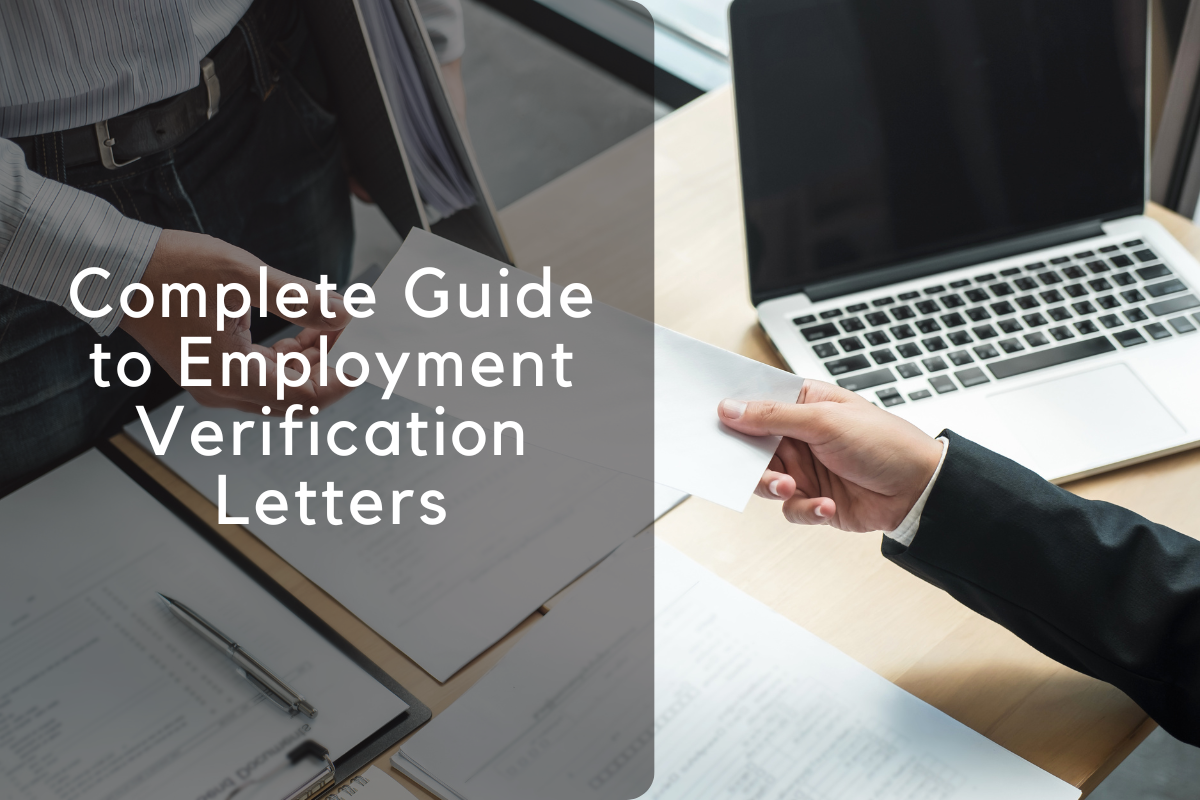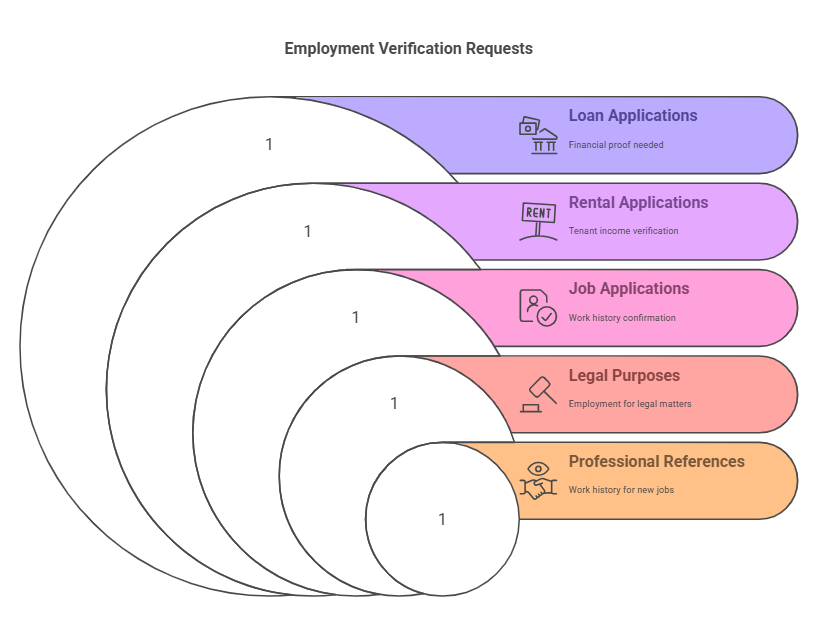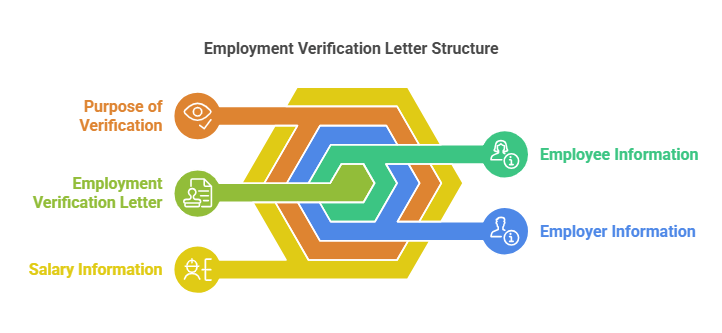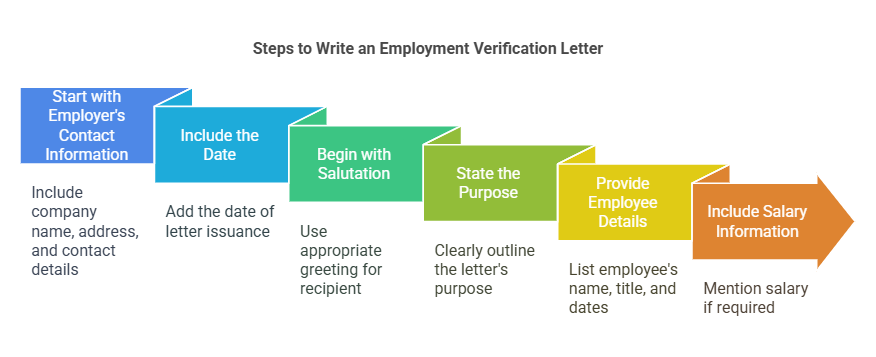Table of Contents
ToggleWhat is an Employment Verification Letter to Whom It May Concern?

An employment verification letter is a formal document issued by an employer to confirm the employment details of an individual. This letter serves as a proof of employment for various purposes, including rental applications, loan applications, or job verifications. It provides essential information about the employee’s job status and role within the company.
What Does “To Whom It May Concern” Mean in This Context?
The phrase “To Whom It May Concern” is a standard formal salutation used when the specific recipient’s name is unknown or irrelevant. In the case of an employment verification letter, this phrase is often used when the letter is intended for multiple potential recipients or a broad audience, such as a landlord, financial institution, or potential employer. It ensures that the letter can be used by various parties without needing to be specifically tailored to one individual.
Why and When is an Employment Verification Letter to Whom It May Concern Used?

An employment verification letters written “to whom it may concern” is typically requested in situations where an individual’s employment details need to be confirmed by a third party, but the specific person or organization requesting the information is not known. Common scenarios in which this letter is used include:
- Loan Applications: Financial institutions may require proof of employment to assess the applicant’s ability to repay a loan.
- Rental Applications: Landlords often request employment verification to ensure that a potential tenant has a stable income and can afford the rent.
- Job Applications: Some employers may ask for verification of past employment to confirm a candidate’s work history.
- Legal and Governmental Purposes: Certain legal processes, such as applying for benefits or resolving legal matters, may require verification of employment.
- Professional References: Former employees may request this letter to verify their work history for new job opportunities.
These scenarios highlight the importance of an employment verification letter in confirming an individual’s job status and providing third parties with the necessary information to make informed decisions.
Key Components of an Employment Verification Letter

An employment verification letter includes specific details that confirm an employee’s work history and status. Common components of such a letter include:
- Employee Information: Full name, job title, employment dates, and a brief description of the role and responsibilities.
- Employer Information: The company’s name, address, and contact details.
- Purpose of Verification: A statement outlining the reason for the verification request (e.g., loan application, rental application).
- Salary Information: If requested, verification of the employee’s salary or wage details, though this is not always included.
The letter serves as an official and legal document confirming the individual’s employment status, which can be essential for various financial, legal, and professional purposes.
How to Write an Employment Verification Letter to Whom It May Concern
Writing an employment verification letter is a straightforward process, but it’s important to include the correct details to ensure that the letter serves its intended purpose. Below is a step-by-step guide on how to write an employment verification letter, along with key components that should be included.
Step-by-Step Guide to Writing an Employment Verification Letter

- Start with the Employer’s Contact Information The first part of the letter should include the employer’s contact details, including the company name, address, phone number, and email address. This makes it easy for the recipient to reach out if they need further information or verification.
- Include the Date The date the letter is written should be included below the employer’s contact details. This provides context for when the letter was issued and helps confirm that the information is current.
- Begin with the Salutation The salutation “To Whom It May Concern” should be used in cases where the specific recipient of the letter is unknown. If you know the name of the recipient, it’s best to address them directly (e.g., “Dear Mr. Smith”). However, if the letter is meant to be general, “To Whom It May Concern” is appropriate and professional.
- State the Purpose of the Letter In the opening sentence or paragraph, clearly state the purpose of the verification. For example, “This letter is to confirm the employment of [Employee Name] at [Company Name].” You can also briefly mention the purpose of the verification (e.g., applying for a loan, renting an apartment).
- Provide Employee Details Include specific details about the employee, such as:
- Full Name: The full name of the employee being verified.
- Job Title: The employee’s current job title.
- Employment Dates: The start date of employment, and if applicable, the end date.
- Job Responsibilities: A brief description of the employee’s main duties, if relevant to the request.
- Salary Information (if required) If the letter needs to verify the employee’s salary, include the employee’s current salary or hourly wage. Be sure to mention whether this information is provided annually, monthly, or weekly, depending on the request. You can phrase it as, “The current annual salary of [Employee Name] is $[amount],” if requested.
- End with a Closing Statement End the letter by offering to provide further information if needed. A common closing line could be: “Should you require any additional information or clarification, please feel free to contact me at [phone number] or [email address].”
- Sign the Letter The letter should be signed by a representative from the company, typically someone from the human resources department or the employee’s direct supervisor. This adds credibility to the letter and confirms its authenticity. Below the signature, include the signer’s name, title, and contact information.
Sample Template for an Employment Verification Letter
Here’s a simple template you can follow when drafting your letter:
[Employer’s Company Name]
[Company Address]
[Phone Number]
[Email Address]
[Date]
To Whom It May Concern,
This letter serves as verification of the employment of [Employee Name] at [Company Name]. [Employee Name] has been employed with our company since [Employment Start Date], and is currently working as a [Job Title]. [He/She/They] is a [full-time/part-time] employee, and [his/her/their] primary duties include [brief job responsibilities].
The current annual salary of [Employee Name] is $[Salary Amount] (if applicable).
If you require any additional information or clarification, please do not hesitate to contact me at [Phone Number] or [Email Address].
Sincerely,
[Signature]
[Name]
[Title]
[Company Name]
[Contact Information]
Best Practices for Employers When Writing an Employment Verification Letter
- Accuracy: Ensure all the details are correct, especially the dates of employment and job title. Any discrepancies can cause delays or questions about the validity of the letter.
- Clarity: Keep the letter clear and concise. Avoid including unnecessary details that may confuse the recipient.
- Confidentiality: Be mindful of what personal information you include, especially salary details. Only provide information that is specifically requested.
- Professional Tone: Maintain a professional and respectful tone throughout the letter. This reflects well on both the employer and the employee.
By following these steps and guidelines, employers can effectively write an employment verification letter to whom it may concern, ensuring it meets the requirements of any third party requesting the verification.
Common Questions, Best Practices, and Conclusion on Employment Verification Letters
Employment verification letters are crucial documents that serve multiple purposes, from confirming job details for rental applications to validating an employee’s income for loan approvals. However, understanding the legal and ethical considerations, as well as best practices for creating an effective letter, can make the process smoother for both employers and employees. Below, we address frequently asked questions and provide tips on handling employment verification letters professionally.
Frequently Asked Questions about Employment Verification Letters
Who Can Request an Employment Verification Letter?
An employment verification letter can be requested by anyone who needs to confirm an individual’s employment status. Common requesters include:
- Landlords: When a tenant is applying to rent an apartment or house.
- Banks and Financial Institutions: To verify income for loan or credit applications.
- Other Employers: To confirm job history during hiring processes.
- Government Agencies: For social security, unemployment claims, or other official matters.
The requester does not need to be an immediate supervisor but can be anyone involved in a transaction where proof of employment is required.
What Are the Legal Implications of Issuing an Employment Verification Letter?
Employers must adhere to privacy laws when issuing employment verification letters. The information included should be truthful, accurate, and only as specific as necessary. Employers should:
-
- Obtain consent from the employee: It is advisable to have the employee's written consent before releasing sensitive information like salary details.
- Follow company policy: Some companies may have specific guidelines on what information can be disclosed in verification letters.
- Avoid sharing confidential information: Be cautious when sharing personal details that are not part of the verification request, such as medical conditions or performance evaluations, unless explicitly required by law.
Can Employers Refuse to Issue an Employment Verification Letter?
While employers are not legally required to provide employment verification letters in most cases, they can refuse if they are not comfortable with the request or if the information is considered confidential. However, denying such a request may harm the employer-employee relationship and can be seen as unprofessional. It's important to clarify company policies on the matter beforehand.
What If There Are Errors in the Employment Verification Letter?
If there are any errors in the employment verification letter, such as incorrect dates or job titles, it is important to correct the mistakes immediately. Both the employer and the employee should communicate openly to ensure the correct information is provided. A corrected letter can be issued, and any discrepancies can be explained if necessary.
How Should Employers Handle Negative References or Issues with Employees' Employment History?
If an employee is in a dispute or has negative references, it is important to address these issues transparently and ethically. For instance, if an employee was terminated, the employer can simply state that the employee is no longer with the company without going into the specifics unless required to do so. Negative feedback or issues should not be disclosed unless legally mandated.
Best Practices for Employers Issuing Employment Verification Letters
- Obtain Consent
Always obtain written consent from the employee before disclosing sensitive information, particularly salary or personal job performance details. This ensures both parties are aware of what will be shared. - Limit Information to What’s Necessary
Provide only the requested information. If a third party requests specific details like salary or job duties, include those only. Avoid over-sharing personal details that could violate privacy or confidentiality. - Be Clear and Accurate
Ensure that all information included in the letter is correct. Double-check employment dates, job titles, and salary figures. Inaccurate details can create confusion or legal issues for both the employer and the employee. - Follow Company Guidelines
Employers should adhere to company policies regarding employment verification. Some companies have set procedures for issuing these letters to ensure that all legal and ethical considerations are met. - Use a Standard Template
Using a standard template for all employment verification letters can save time and ensure consistency. A template also ensures that important details are always included, helping to avoid missing any critical information. - Maintain Confidentiality
Respect the privacy of employees by keeping sensitive data confidential. Employers should only provide the details necessary to fulfill the request and avoid disclosing information not directly related to the employment verification.
Conclusion
An employment verification letter is an essential tool that serves various purposes, from confirming job status to validating income. By understanding when to issue one, following best practices, and handling any requests with care, employers can ensure the process is professional and efficient. Both employees and employers should work together to ensure that the letter accurately reflects the necessary details and adheres to legal and company policies.
By implementing these best practices and addressing common questions, employers can streamline the process of issuing employment verification letters while maintaining transparency and professionalism.
